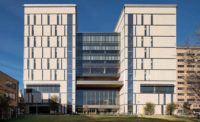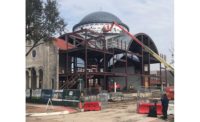Featuring the world's largest drainage pump station and the largest navigable floodgate in the U.S., the $1-billion Gulf Intracoastal Waterway West Closure Complex is a critical part of the Hurricane and Storm Damage Risk Reduction System that will provide the New Orleans area with 100-year-event flood protection. Gulf Intracoastal Constructors, a joint venture of Kiewit Infrastructure South and Traylor Brothers Inc., completed construction in June 2012.
The complex provides flood risk reduction and storm surge defense, and consists of multiple structures located across the entire waterway, just south of the Algiers and Harvey canals.
"Those two canals, Algiers and Harvey, drain that entire area, and they enter into what is the continuation of the Gulf Intracoastal Waterway and that goes out eventually to the Gulf of Mexico," says Dennis M. Kamber, senior vice president at ARCADIS. "What happens is when you get a hurricane, if it's coming in at the right direction and the right intensity, it starts pushing water up that Gulf Intracoastal Waterway, past this point, and it goes up into those canals. They have some levees and floodwalls, but in a big storm surge, they're just not adequate. That surge would move up there and flood that entire area. What this project does essentially is put a barrier across the waterway, so when a surge tries to push up, the barrier stops it."
Part of the complex is a 225-ft sector gate, with two leafs, each weighing 660 tons. When this gate is closed, the barrier to the Algiers and Harvey canals is complete. "In a hurricane, there is a tremendous amount of rainfall, so that whole area behind this barrier that's drained by those canals, would start backing up and flood the area. The pump station takes all that water out of there and pumps it out to the seaward side," Kamber explains.
This massive pumping station was constructed of 56,900 cu yd of concrete and 12 million lb of rebar. Longer than two football fields, the station complex is equipped with 11 "flower pot"-type pumps, each powered by a 70-ton, 5,400-horsepower engine.
With this kind of power, the station is capable of pumping stormwater at a rate of about 20,000 cu ft per second—fast enough to fill an Olympic-size swimming pool in three seconds. Also included in the complex are a "combi-wall" cofferdam and a floodwall consisting of 17,249 cu yd of concrete.
"The project utilized early contractor involvement procurement. This procurement model means the design was handled entirely by the Army Corps of Engineers," says John Proskovec, Kiewit's area manager supervising the project. "This was the first major civil infrastructure project in the country on which the Corps has used this procurement model, so it was a learning experience for everyone involved. This process is very similar to design-build, other than that the designer works for the owner and not the contractor."
One of the major challenges was to design and build this mammoth project in just 18 months, Proskovec says. "Getting early design packages out the door and starting construction were both very time critical," he says. "Since the contractor did not have any control over the design, coordination and communication among the Corps, the designers and the contractor was critical to the project's success."
Proskovec adds that "in order to do this we started several processes that everyone bought into and agreed to make work," including a senior-level oversight group, which brought together top managers once a quarter, as well as daily meetings at which team members could discuss design and construction issues.
"Because of the sheer size and magnitude of this, it required a lot of very creative engineering," says Kamber. "Everything had to be designed from scratch. There weren't even pump manufacturers in this country that could guarantee that they could produce pumps of these sizes and deliver them in the time that we needed. There were only a couple that could do that."
The team also didn't have time to do advance hydraulic modeling, which is normally done for a facility this size, instead designing the complex while the model was being built. "We had to design it and hopefully make whatever adjustments were necessary after the model was complete," says Kamber. "Actually, it worked out very well. The physical models that were constructed just validated what our computational models had indicated. So we didn't need to make many adjustments at all to this design."
Proskovec notes that "although there were a lot of great technologies used on the projects, the 3D schedule was one of the most notable. It was a very visible way to see the progress of the construction. We used it many times to brainstorm ways to minimize schedules or see conflicts ahead of time."
Since the pump station must operate under extreme conditions and withstand Category 5 hurricane force winds without failure, reliability and fail-safe elements were incorporated into every aspect of the project, including a safe house for employees, diesel fuel systems and standby generators to provide uninterrupted electrical service as well as wastewater treatment and potable water supply systems.







